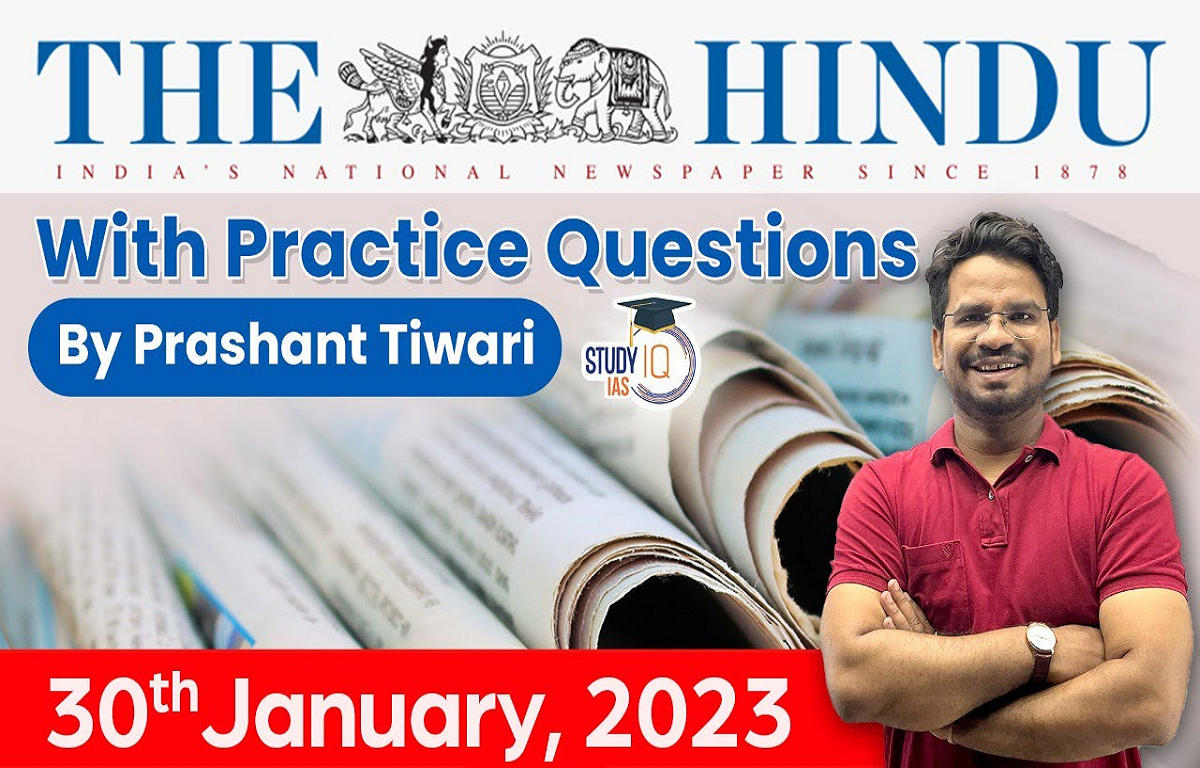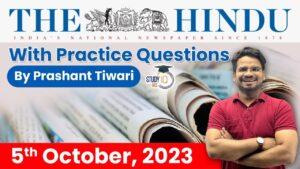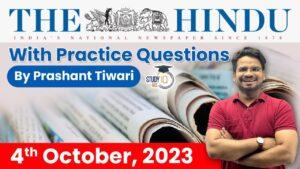The Hindu Newspaper Analysis for UPSC

The Hindu Newspaper Analysis 25 January 2023
- The Union Ministry of Education on Sunday released data from the All India Survey on Higher Education (AISHE), 2020-2021, which showed a 7.5% increase in student enrolments across the country compared to 2019-20, with total student enrolments reaching 4.13 crore.
- The survey also revealed that in 2020-21, the year when the COVID-19 pandemic began, there was a 7% rise in enrolments in distance education programmes.
- Proportion of SC, OBC, Muslim enrolments down compared to the previous year; number of colleges increased by 1,453; teachers belonging to SC and ST communities continued to be under-represented; 75 women teachers to every 100 male ones across institutes in country
- The teacher-pupil ratio was at 27 for all universities, colleges and standalone institutions and at 24 if only regular mode is considered. It concluded that the best teacher-pupil ratio was found in States like Tamil Nadu and Karnataka.
- While Uttar Pradesh; Maharashtra; Tamil Nadu; Madhya Pradesh; Karnataka and Rajasthan are the top 6 States in terms of number of students enrolled, Uttar Pradesh; Maharashtra; Karnataka; Rajasthan; Tamil Nadu; Madhya Pradesh; Andhra Pradesh and Gujarat are the top 8 States in terms of number of colleges, the report further said.

- The Mahatma Gandhi National Rural Employment Guarantee Act (MGNREGA) is no stranger to reform.
- The most recent concern of the central government is over the programme’s “regressive” spending pattern, where poorer States spend less NREGA funds than better-off ones. As if on cue, a committee to suggest reforms has been constituted instead of listening to the long-standing demands of workers and their collectives.
- NREGA is underperforming because its most basic design principles have been forgotten or wilfully ignored.
- The first is: address delays in wage payments to restore the faith of workers in the programme. In 2016, the Supreme Court of India directed the government to ensure that wages were paid on time, calling the act of making workers wait for wages for months as equal to “forced labour”.
- The second is: strengthen implementation capacities where expenditure is low instead of curbing expenditure where employment generation is high.
- The third is: run the programme like a demand-based law, and not a scheme. Intermittent and unpredictable fund releases by the central government are one of the fundamental reasons why State governments are unable to ensure the full potential of NREGA. As of today, ₹18,191 crore in liabilities is due to 24 States.
- The Kaam Mango Abhiyan was launched by the Ministry of Rural Development in 2013 — due to declining demand of work under NREGA), the Union Ministry of Rural Development launched this campaign, which literally means “ask for work” — with the help of civil society organisations in six districts in six States; 53,000 workers demanded work in Katihar district alone and dated receipts were provided.

- The Mahatma Gandhi National Rural Employment Guarantee Act (MGNREGA), also known as Mahatma Gandhi National Rural Employment Guarantee Scheme (MNREGS) is Indian legislation enacted on August 25, 2005.
- The MGNREGA provides a legal guarantee for one hundred days of employment in every financial year to adult members of any rural household willing to do public work-related unskilled manual work at the statutory minimum wage.
Eligibility Criteria
- Must be Citizen of India to seek MGNREGA benefits.
- Job seeker has completed 18 years of age at the time of application.
- The applicant must be part of a local household (i.e. application must be made with local Gram Panchayat).
- Applicant must volunteer for unskilled labour.

- Adam Smith, in his famous work The Wealth of Nations, argued that commodities such as sugar, rum and tobacco, though not necessary for life, are widely consumed, and thus good candidates for taxation.
- However, in India, tobacco taxes have not increased significantly since the implementation of the Goods and Services Taxation (GST) over five years ago, making these products increasingly affordable, as recent studies show.
- One issue is the overuse of ad valorem taxes, which are not effective in reducing consumption. Many countries use a specific or mixed tax system for harmful products.
- An ad valorem tax is a tax based on the assessed value of an item such as real estate or personal property. All ad valorem taxes are levied based on the determined value of the item being taxed.
- There is a large discrepancy in taxation between tobacco products. Despite cigarettes accounting for only 15% of tobacco users, they generate 80% or more of tobacco taxes. Bidis and smokeless tobacco have low taxes, encouraging consumption.
- Taxes should be made more consistent across all tobacco products, as none is more or less harmful than the others. The main principle behind tobacco taxation should be in protecting public health.
- It is cause for concern that while most countries regularly increase taxes on tobacco products to make them less affordable, India has not increased taxes on any tobacco products in over five years. This may undo much of the progress seen in a 17% reduction in tobacco use from 2009-10 to 2016-17.

- The Justice G. Rohini-led commission for the sub-categorisation of other backward classes (OBCs) has now been given yet another extension in its tenure by the President, according to a gazette notification issued by the Union Ministry of Social Justice and Empowerment last week.
- This is the 14th extension in tenure that the commission has been given. The commission, formed in October 2017, was initially given 12 weeks to finish the task of sub-categorising the nearly 3,000 castes within the OBC umbrella and recommend division of the 27% OBC quota among them equitably.
- Initially, the government cited more time required by the panel to gather information and data and then it cited the pandemic.

- The notice follows Pakistan’s continued “intransigence” in implementing the treaty, by raising repeated objections to the construction of hydel projects on the Indian side.
- India is invoking Article XII (3) of the treaty to bring changes to the 1960 pact.
- IWT is a water-distribution treaty between India and Pakistan, brokered by the World Bank (WB), to use the water available in the Indus River and its tributaries. It is often cited as an example of the possibilities of peaceful coexistence despite the troubled relationship.
- It was signed in Karachi in 1960 by then-Indian PM Jawaharlal Nehru and then-Pakistani president Ayub Khan.
- The Treaty gives control over the waters of the three “eastern rivers” – the Beas, Ravi and Sutlej (BRS)- to India, while control over the waters of the three “western rivers” – the Indus, Chenab and Jhelum -has been given to Pakistan.

- The treaty allows India to use the western river waters for limited irrigation use and unlimited non-consumptive use for such applications as power generation.
- India has the right to generate hydroelectricity through run-of-the-river (RoR) projects on the western rivers which, subject to specific criteria for design and operation, is unrestricted.
- The dispute redressal mechanism provided under the IWT is a graded 3-level mechanism.
- Under the IWT, whenever India plans to start a project, it has to inform Pakistan. The concerns have to be cleared at the levels of the Indus Commissioners → Neutral Expert → Court of Arbitration, in a graded manner.


 The Hindu Newspaper Analysis 6 October 2...
The Hindu Newspaper Analysis 6 October 2...
 The Hindu Newspaper Analysis 5 October 2...
The Hindu Newspaper Analysis 5 October 2...
 The Hindu Newspaper Analysis 4 October 2...
The Hindu Newspaper Analysis 4 October 2...

















